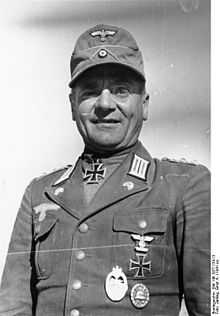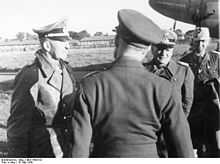Hans Cramer
| Hans Cramer | |
|---|---|
 Oberst Hans Cramer in 1941 | |
| Born |
13 July 1896 Minden, North-Rhine Westphalia |
| Died |
28 October 1968 (aged 72) Porta Westfalica, North-Rhine Westphalia |
| Allegiance |
|
| Service/branch |
Deutches Heer (1914-1919) Reichswehr (1919-1935) Wehrmacht/Heer (1935–45) |
| Rank | General der Panzertruppe |
| Commands held |
Panzer-Regiment 8 Deutsches Afrika Korps |
| Battles/wars |
World War I World War II |
| Awards | Knight's Cross of the Iron Cross |
General Hans Cramer (13 July 1896 – 28 October 1968) was a Panzer General in the German army who fought against the British in both world wars.
Career
Cramer joined the Prussian Army on 10 August 1911 as an Ensign in the 2. Westphalian Infantry Regiment "Prinz Friedrich der Niederlande" Nr. 15. He was promoted to Leutnant in December 1914 and became both a Company Commander and Battalion Adjutant before his capture by the British in August 1918. During the war he received both classes of the Iron Cross
Released in the spring of 1919 he was retained in the Reichswehr. He initially served in the 18th Infantry Regiment and joined the 13th Cavalry Regiment on 1 January 1923. After service in various other units he was promoted to Hauptmann on 1 February 1931, and became an instructor at the Cavalry School in 1934. On 1 January 1936, he was promoted to Major and on 1 February 1939 to Oberstleutnant while serving as Commander of the Kavallerie-Lehr- und Versuchs-Abteilung (Cavalry Training and Experimental Detachment).
After the mobilization he was on 26 August 1939 appointed Commander of the Reconnaissance Training Detachment and let it into the war against Poland. On 1 October 1941, after receiving both clasps of the Iron Cross, he was promoted to Oberst and was posted to the Panzer-Regiment 10. On 25 March 1941 he was appointed Commander of Panzer-Regiment 8, part of the 15th Panzer Division. In April 1941, his unit became part of the German Africa Korps. On 24 June 1941 he was severely wounded in the battle of Sollum, part of Operation Battleaxe, and three days later was awarded Knight's Cross of the Iron Cross for his role in the battle. On 1 March 1942 Cramer was appointed as Chief of Staff to the "General der Schnellen Truppen" ("General of Fast Troops", the Chief of Armoured Troops, Mechanized Troops and Cavalry) at the OKH, at the same time receiving the German Cross in Gold. On 1 November he was promoted to Generalmajor and was himself apppointed to the post of General der schnellen Truppen. During late 1942 he temporarily commanded the XXXVIII. Panzerkorps and in January 1943 he temporarily commanded the rebuilding XI. Armeekorps.

On 22 January 1943 he was again promoted to Generalleutnant and in February he returned to Africa as Commander of the Afrika Korps. On 1 May 1943 he received his final promotion to General der Panzertruppe and on 12 May 1943, with the capitulation of the German forces in North Africa, he was taken into captivity by the British. From 16 May on he was held in the special prison for captured German generals and staff officers at Trent Park. He was exchanged in May 1944 and returned to Germany, reportedly because of his problems with asthma. During his repatriation journey, he was allowed to see Montgomery's 21st Army Group preparing for the invasion of Europe, but was told he was in Kent, where Patton's mythical 1st U.S. Army Group was preparing for its invasion. This was part of the broader Allied deception campaign, Operation Fortitude, prior to D-Day.
After repatriation Cramer was appointed to Panzer Group West in France as a Supernumerary. As former prisoner of war he fell under suspicion of complicity after the 20 July plot; the fact that he and Claus von Stauffenberg were former comrades at the Cavalry School not speaking for him. He was placed under arrest on 26 July, and held in the Gestapo prison on the Prinz-Albrecht-Strasse in Berlin and then in a satellite of the Ravensbrück concentration camp until 5 August 1944. On 14 September 1944 he was dismissed from the Wehrmacht. From 24 December 1944 until the German surrender he was under house arrest.
Following the war the British appointed Cramer as Supreme Commander of all the German troops captured in Holstein, and he held this position from May 1945 until 15 February 1946. Living in Porta Westfalica, right next to his birthplace Minden, he wrote the manuscript for a book about his time with the Cavalry Training and Experimental Detachment. It was published posthumously in 1972 as Die Panzer Aufklärungs-Lehrabteilung (Kavallerie Lehr-und Versuchsabteilung) von 1937-1940, as Cramer died on 28 October 1968.
Awards

- Iron Cross (1914)
- 2nd Class
- 1st Class
- Very Lippisches War Cross for heroic action
- War Merit Cross (Lippe)
- Lippe Cross for Faithful Service
- Wound Badge (1918) in Silver
- Honour Cross of the World War 1914/1918
- Wehrmacht Long Service Award, 4th class with 1st class
- Clasp to the Iron Cross (1939)
- Panzer Badge in Silver (4 October 1941)
- German Cross in Gold (5 March 1942)
- Knight's Cross of the Iron Cross on 27 June 1941 as Oberstleutnant and commander of Panzer-Regiment 8 im DAK[2]
- Ärmelband Afrika
- Commander's Cross of the Colonial Order of the Star of Italy (7 May 1942)
References
- Citations
- Bibliography
- Federl, Christian (2000). Die Ritterkreuzträger der Deutschen Panzerdivisionen 1939–1945 Die Panzertruppe [The Knight's Cross Bearers of the German Panzer Divisions 1939–1945 The Panzer Force] (in German). Zweibrücken, Germany: VDM Heinz Nickel. ISBN 978-3-925480-43-0.
- Fellgiebel, Walther-Peer (2000). Die Träger des Ritterkreuzes des Eisernen Kreuzes 1939–1945 – Die Inhaber der höchsten Auszeichnung des Zweiten Weltkrieges aller Wehrmachtteile [The Bearers of the Knight's Cross of the Iron Cross 1939–1945 — The Owners of the Highest Award of the Second World War of all Wehrmacht Branches] (in German). Friedberg, Germany: Podzun-Pallas. ISBN 978-3-7909-0284-6.
- Neitzel, Sönke (2007). Tapping Hitler's Generals: Transcripts of Secret Conversations, 1942-1945. Frontline Books. ISBN 978-1-84415-705-1.
- Scherzer, Veit (2007). Die Ritterkreuzträger 1939–1945 Die Inhaber des Ritterkreuzes des Eisernen Kreuzes 1939 von Heer, Luftwaffe, Kriegsmarine, Waffen-SS, Volkssturm sowie mit Deutschland verbündeter Streitkräfte nach den Unterlagen des Bundesarchives [The Knight's Cross Bearers 1939–1945 The Holders of the Knight's Cross of the Iron Cross 1939 by Army, Air Force, Navy, Waffen-SS, Volkssturm and Allied Forces with Germany According to the Documents of the Federal Archives] (in German). Jena, Germany: Scherzers Miltaer-Verlag. ISBN 978-3-938845-17-2.
| |||||||||||||||||||||||||||||||||||||||||||||
|
